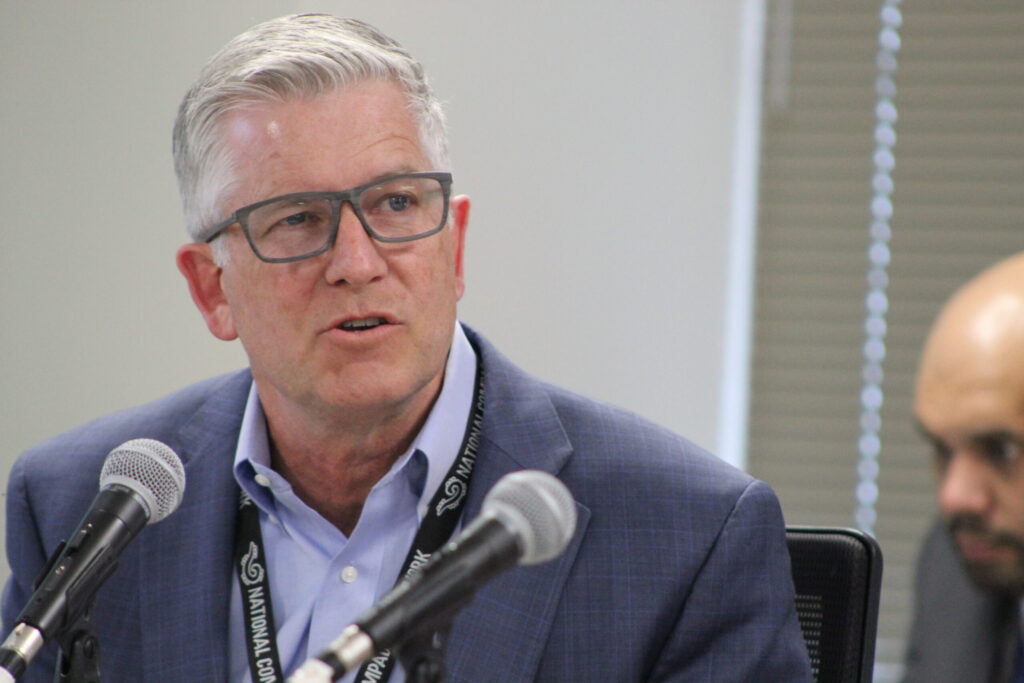Wolves already ravaging Colorado farm animals, families, finances | GABEL


The truck rolled into the Anderson’s ranch near Walden early on a Friday morning. By about 6 a.m., Brian Anderson was bringing cull cows down the alley and up the ramp into the bull rack trailer. The sounds of cows trotting down the alley, up the metal loading chute and onto the trailer made the morning hum with the sounds of fall in cow country.
Rolling aluminum doors on the trailer rattled, rolled down and shut with a solid slam. As daylight arrived completely, the ranch was fully awake, ewes were calling for feed, mother cows were calling for the calves that were standing and stretching with their tails straight up in the air. Fall temperatures flirted with single digits and steam rolled off the cows milling around in a pen. Diesel trucks and pickups purred, and the loaded truck and trailer rattled over a cattle guard on the way to town.
Anderson, who also works as the local brand inspector, ranches with his brother and his dad, Phillip. The family runs a couple hundred cow calf pairs and used to run a sizable flock of sheep. Now, Brian and his wife, Faith, and their children run a small flock of about 30 ewes. Phillip was out checking mineral tubs when he called Brian to tell him he had found some dead ewes.
The three ewes, Hampshire Suffolk crosses, were replacements kept back to add to the breeding flock as they best combined genetic potential and phenotype. The Anderson kids are 4-H members, and they keep wethers out of their own flock to show at the county fair. They also show market steers, and the show string – Mr. Frimple Pants and Oreo, among them – were watching the commotion of the morning.
The trio of dead ewes were strung out in a line, about 100 yards from Brian’s front door. They all had puncture wounds, claw marks and bruising. One had her udder eaten away. Another had her wooly skin torn from her flank, exposing the muscles and tendons. They hadn’t been eaten, just killed. One was still warm to the touch, like she had met her demise only an hour or so earlier. Perhaps the cattle truck rolling into the yard had spooked the attacker.
Stay up to speed: Sign-up for daily opinion in your inbox Monday-Friday
Brian called Colorado Parks and Wildlife and the area wildlife manager arrived quickly and performed necropsies on the ewes. They studied telemetry data, confirmed a collared wolf had been in the area, and boots-on-the-ground CPW staff ruled the depredations due to wolves, likely just one. Anderson was given a stack of paperwork to attempt to earn compensation for the value of the three ewes. On paper, the ewes are worth about $2 per pound and at about 110 pounds, they would bring just more than $200 each. Over their productive life, though, they would ideally produce 20 lambs each. On paper, the lambs entering the food supply could go through Anderson’s farm to a plate meat company or be marketed at the local grocery store to bring income to both the ranch and the small community of Walden.
Determining the value of livestock isn’t an exact science. To Anderson’s 8-year-old daughter, the value may lie in the excitement of the upcoming lambing season. Bottle babies aren’t the goal, but the chance to snuggle one, nurse him through the tough days and the reward of having a devoted pal for life is where the value can be found. For another of the Anderson kids, the value is in the years she spent investing time and energy into her 4-H lambs so she could reinvest her proceeds into her flock. The flock was built one by one, chosen carefully by evaluating their genetic potential and ability to raise lamb crops. After nearly a year of work preparing for the show, tears will be shed after the junior market livestock sale, even by kids who understand how the story ends.
The value may be in the investment the Andersons made during the previous calving season when Phillip, who is the immediate past president of the Colorado Cattlemen’s Association, and Brian, a board member on the North Park Stockgrowers Association, put their money where their mouths are and installed fladry fencing during calving season. Brian concluded months ago that maintaining the family’s long relationship with local CPW staff and finding a way to deal with the presence of wolves is a nonnegotiable for a man who wants to see his kids ranch in the big country – the wolf country – about 20 miles south of the Wyoming border.
Rachel Gabel writes about agriculture and rural issues. She is assistant editor of The Fence Post Magazine, the region’s preeminent agriculture publication. Gabel is a daughter of the state’s oil and gas industry and a member of one of the state’s 12,000 cattle-raising families, and she has authored children’s books used in hundreds of classrooms to teach students about agriculture.













